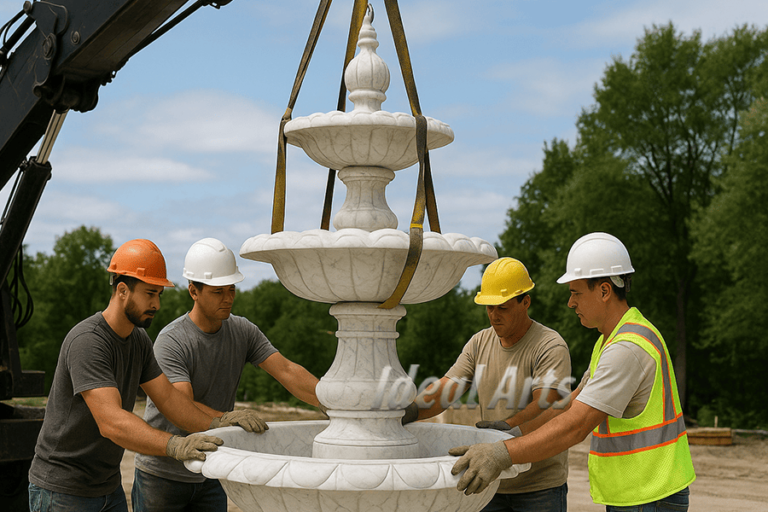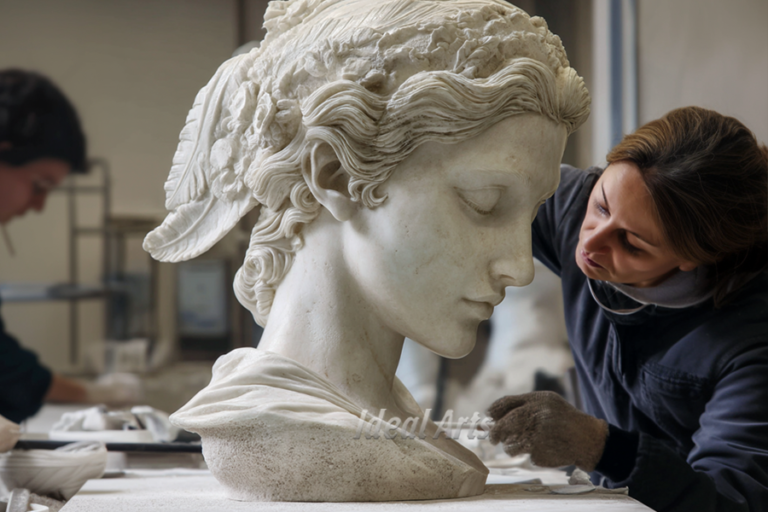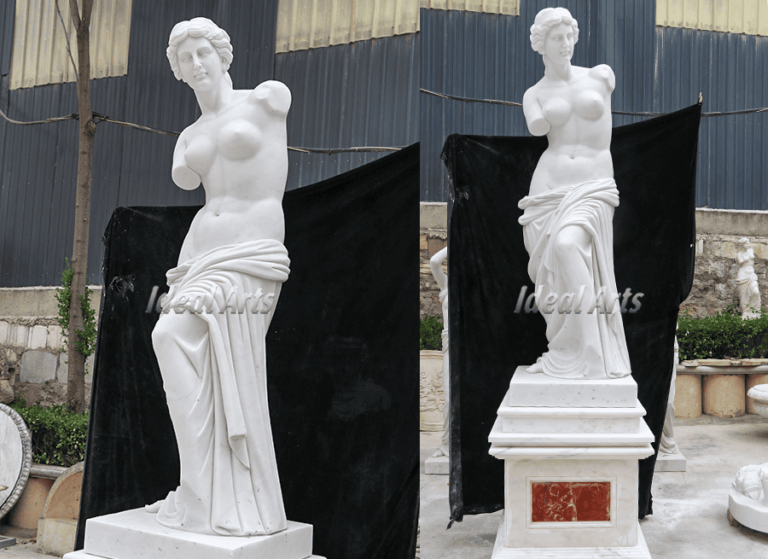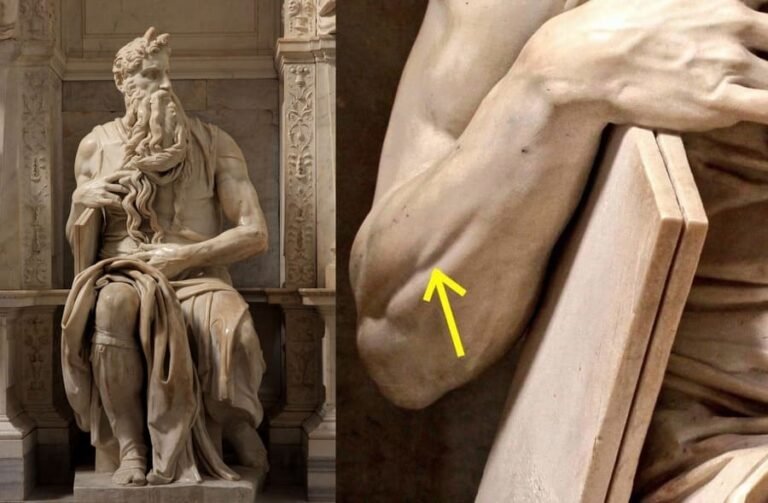The image of Mary holding Jesus is one of the most powerful symbols in religious art. This sculpture, known as the Pietà, captures a deep emotional moment that resonates with millions worldwide. It depicts the Virgin Mary cradling the lifeless body of Jesus after the crucifixion, symbolizing love, sorrow, and divine sacrifice.
The Pietà is a Renaissance masterpiece by Michelangelo, created in 1498-1499 when he was just 24 years old. It remains one of the most revered sculptures in history, admired for its lifelike detail, artistic beauty, and profound emotional depth.

Who sculpted the Pietà?
Michelangelo sculpted the Pietà, completing it between 1498 and 1499. This work is considered one of his greatest masterpieces and is housed in St. Peter’s Basilica in Vatican City.
Michelangelo’s Early Mastery
Michelangelo, one of the most famous artists of the Renaissance, created the Pietà when he was still a young man. He was commissioned by a French cardinal, Jean de Bilhères-Lagraulas, who wanted a magnificent sculpture for his tomb.
Michelangelo selected Carrara marble for this project, a material known for its pure white color and fine texture. He worked tirelessly, sculpting with precision to bring his vision to life. His technique displayed his ability to carve soft, flowing drapery, realistic anatomy, and deep emotion.
Artistic Choices in the Pietà
One of the most striking aspects of Michelangelo’s Pietà is Mary’s youthful appearance. Unlike other representations of Mary, which often depict her as an older woman, Michelangelo chose to portray her as a young and serene figure. He explained that her purity and holiness kept her youthful.
Another remarkable artistic choice is the delicate balance of sorrow and peace in Mary’s expression. She does not appear overwhelmed with grief but instead exhibits quiet acceptance. This subtlety adds to the sculpture’s emotional power.

| Key Facts About the Pietà | Details |
|---|---|
| Sculptor | Michelangelo Buonarroti |
| Year Created | 1498-1499 |
| Material | Carrara marble |
| Current Location | St. Peter’s Basilica, Vatican City |
| Commissioned By | Cardinal Jean de Bilhères |
Michelangelo’s Signature on the Pietà
Interestingly, the Pietà is the only work Michelangelo ever signed. After hearing rumors that other artists were being credited for his masterpiece, he secretly carved his name on Mary’s sash:
“MICHAEL.A[N]GELUS BONAROTUS FLORENTIN[US] FACIEBAT”
(Translation: “Michelangelo Buonarroti, Florentine, made this.”)
Later, Michelangelo regretted signing it and vowed never to sign his work again.
Michelangelo’s Pietà set a new standard in sculpture, blending technical mastery with profound spirituality. To this day, it stands as a testament to his genius.
What Does Mary Holding Jesus Represent?
What emotions does this iconic image evoke? The Pietà is a powerful symbol of grief, sacrifice, and divine love.
The sculpture captures Mary mourning Jesus after the Crucifixion. Her sorrow is evident, yet she remains serene, reflecting her acceptance of God’s will. This moment is not just about loss—it represents the ultimate sacrifice made for humanity’s salvation.

The Deeper Symbolism of the Pietà
The Pietà is deeply rooted in Christian tradition and theology. It highlights:
- Mary’s Sorrow – She is often called the “Mater Dolorosa” (Sorrowful Mother), representing the pain of all who have lost loved ones.
- Jesus’s Humanity – His lifeless form emphasizes his suffering and sacrifice.
- A Mother’s Love – The way Mary cradles Jesus is a universal symbol of parental love and protection.
- Hope Beyond Death – While tragic, the scene also hints at the Resurrection and the promise of eternal life.
Symbolism in the Pietà
| Symbol | Meaning |
|---|---|
| Mary’s youthful face | Represents purity, eternal motherhood, and divine grace. |
| Jesus’ lifeless body | Symbolizes sacrifice and redemption. |
| Mary’s open left hand | Acceptance of God’s will. |
| The flowing drapery | Symbolizes movement and grace. |
| Jesus’ peaceful expression | Highlights the victory over death and suffering. |
Unlike traditional depictions of the Virgin Mary, Michelangelo sculpted her as young and serene, rather than aged and sorrowful. This choice emphasizes her eternal purity and divine nature.
Michelangelo’s composition is intentionally intimate, inviting viewers to connect with the emotions of the piece. The folds of Mary’s robe, the soft positioning of Jesus’s body—every detail adds to the sculpture’s deep emotional impact.
Why Is the Pietà So Important?
Why does the Pietà continue to captivate audiences worldwide? It’s not just its beauty—it’s the profound message it carries.
The Pietà is important because it is both a masterpiece of Renaissance art and a symbol of deep religious devotion. Michelangelo’s ability to carve human emotion into marble set a new artistic standard, and its spiritual message continues to resonate with millions.
Artistic and Cultural Impact
The Pietà marked a turning point in sculpture. Michelangelo’s skill in creating lifelike figures, naturalistic drapery, and deep emotional expression influenced generations of artists. It remains a hallmark of Renaissance humanism, celebrating both the divine and the human experience.
Religious Significance
For Christians, the Pietà is a powerful reminder of sacrifice and redemption. It has been a source of prayer, reflection, and solace for centuries, inspiring countless believers.
Even beyond religion, its universal themes—grief, love, and hope—make it a deeply moving work of art.
Why Is the Pietà Important to Catholics?
For Catholics, the Pietà is more than just a sculpture—it is a sacred representation of faith and suffering.
The Catholic tradition places great importance on Mary’s role in salvation history. The Pietà visually expresses her pain as the Mother of Sorrows, mirroring the Seven Sorrows of Mary often reflected upon in Catholic devotion.

How the Pietà Connects to Catholic Teachings
- Mary as the Intercessor – Catholics believe Mary continues to intercede for humanity, sharing in our suffering and guiding us to Christ.
- A Meditation on Christ’s Passion – The Pietà is a visual aid for reflecting on Jesus’s sacrifice during the Crucifixion.
- A Call to Compassion – By witnessing Mary’s sorrow, believers are reminded to show mercy and empathy in their own lives.
The Pietà is often used during Holy Week meditations and is a central symbol in Catholic devotional practices.
What is the Composition of the Pietà?
The Pietà is one of the most beautifully structured sculptures in Renaissance art. Its composition is carefully designed to create harmony, stability, and emotional depth. Michelangelo’s masterful arrangement of the figures enhances the dramatic yet serene effect of the scene, allowing viewers to engage deeply with the emotions it conveys.

Pyramidal Composition: The Foundation of the Pietà
Michelangelo structured the Pietà in a pyramidal shape, a common technique in Renaissance art to create stability and a natural flow for the viewer’s eye. In this case, the base of the pyramid is Mary’s wide robe, and its peak is Mary’s head.
This triangular structure serves multiple purposes:
- Directs Focus – The shape guides the viewer’s eye naturally from Mary’s face down to Jesus’ body, emphasizing their emotional connection.
- Creates Stability – The wide base and gradually tapering top prevent the composition from feeling unbalanced or chaotic.
- Symbolizes Strength and Support – The base of the pyramid (Mary’s body and robe) acts as a foundation for the composition, symbolizing her strength as a mother and a pillar of faith.
By using this strong, geometric structure, Michelangelo creates a composition that feels both solid and graceful, reinforcing the timeless and divine quality of the sculpture.
Mary’s Larger Proportions: A Deliberate Distortion
Although at first glance the Pietà appears perfectly proportioned, Michelangelo made a key artistic decision that defies natural anatomy:
- Mary’s body is significantly larger than Jesus’ body.
- If she were to stand up, she would appear unnaturally tall and oversized.

Why Did Michelangelo Make Mary Larger?
| Reason | Effect |
|---|---|
| Practical Support | A naturally proportioned Mary would struggle to hold a grown man in her lap. The enlarged body ensures she can cradle Jesus without appearing strained. |
| Symbolic Meaning | Mary is depicted as a mother beyond human limits, representing divine motherhood rather than just a physical one. |
| Visual Balance | A proportionally accurate Mary would have appeared too small at the base of the pyramid, disrupting the stability of the composition. |
| Artistic Idealism | Renaissance artists often modified human proportions to emphasize key themes—here, Mary’s exaggerated size makes her appear eternal and nurturing. |
This choice ensures that Mary remains the dominant figure in the composition, reinforcing her role as both a grieving mother and a figure of divine compassion.
Drapery and Folds: Enhancing Movement and Realism
Michelangelo’s sculpting of Mary’s robes is one of the most detailed aspects of the Pietà. The folds and drapery serve multiple artistic and symbolic purposes:
- Creates Movement – The flowing fabric softens the composition, giving the illusion that the figures are alive rather than static.
- Adds Visual Depth – The contrast between the heavy folds of Mary’s robe and the smooth body of Jesus creates a dynamic interplay of textures.
- Symbolizes Grace – The drapery represents Mary’s divine grace, as if she is enveloped in a celestial garment.
- Enhances Light and Shadow – The intricate carving of the folds interacts with light, producing dramatic shadows and highlights that make the sculpture feel more lifelike.
Michelangelo’s technique in sculpting fabric from marble is extraordinary. The deep cuts in the robe give the illusion of softness, while the overall composition remains strong and structured.
What Are the Materials Used in La Pietà?
The Pietà was carved from a single block of Carrara marble, a material known for its purity, smooth texture, and durability.

Why Did Michelangelo Choose Carrara Marble?
- Strength and Longevity – Ensures the sculpture withstands time.
- Translucent Quality – Gives the illusion of soft, lifelike skin.
- Fine Grain – Allows for intricate detailing, such as facial expressions and fabric folds.
- Symbolic Meaning – White marble represents purity and divinity.
Carrara marble is one of the most prized materials in sculpture and was used for other masterpieces like Michelangelo’s David.
Is Jesus Dead in the Pietà?
Yes, Jesus is depicted after his crucifixion, lying peacefully in Mary’s arms. However, Michelangelo presents him with grace and serenity rather than suffering.
Unlike other Passion of Christ artworks, which emphasize pain, the Pietà highlights Jesus’ divine acceptance of his fate and the promise of resurrection.

Marble and Bronze Pietà Sculptures
We offer high-quality Pietà sculptures in both marble and bronze, each with its own unique advantages. Our sculptures are crafted with great care to maintain the beauty and details of Michelangelo’s masterpiece.

Comparison of Marble and Bronze Pietà Sculptures
| Specification | Bronze Pietà Sculpture Advantages | Marble Pietà Sculpture Advantages |
|---|---|---|
| Material | Bronze/Brass | Pure natural marble |
| Size | Life-size or custom dimensions | Life-size or custom dimensions based on preference |
| Technique | Lost-wax casting | Pure hand-carved deep engraving |
| Color | Antique bronze or custom colors | White, beige, or other custom colors |
| Packaging | Soft waterproof plastic, wooden/iron crate | Soft waterproof plastic, wooden/iron crate |
| Installation | Extra-large bronze sculptures can be installed separately | Extra-large marble sculptures can be installed separately |

Choosing the Right Pietà Sculpture for You
- Bronze Pietà: Ideal for outdoor installations due to its durability and resistance to weather conditions.
- Marble Pietà: Best suited for indoor spaces or chapels, offering an elegant and traditional aesthetic.
We can also customize your Pietà sculpture based on size, color, and material to meet your specific needs. Contact us to learn more about our handcrafted marble and bronze Pietà statues.






